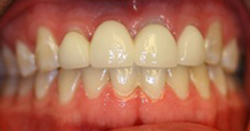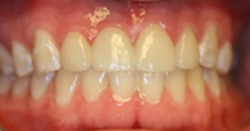Teeth that are cracked, broken down, or otherwise damaged can often be restored. Dental crowns placed by Dr. Arash Azarbal, our extensively trained cosmetic dentist, can not only save your teeth but also give you a beautiful cosmetic result. His customized, natural-looking, crowns are strong and virtually identical to your natural teeth.
- Dental Crown Overview
- When Is a Dental Crown Necessary
- Dental Crown Options
- Dental Crown Benefits
- Dental Crown Appearance
- Dental Crown Results
- Dental Crown Cost
- CEREC Dental Crowns
- Why Choose Porcelain Crowns from a Cosmetic Dentist?
What Is a Porcelain Crown?
A porcelain crown is often referred to as a “cap.” A crown covers the entire tooth from the biting surface to the gum line. This effectively rebuilds the missing tooth structure and provides support for the remaining healthy tooth structure. Many people think that a tooth that is badly broken down or decayed must be extracted. But often it is possible to save the tooth and beautifully restore it with a traditional porcelain crown, a CEREC® crown, or other option.
When Is a Dental Crown Necessary?
Dental crowns are needed when a tooth has a large area of decay that cannot be adequately treated with just a filling. A crown covers the entire chewing surface of the tooth and wraps around the sides of the tooth, extending to the gum line (thus rebuilding missing tooth structure and providing support for the remaining tooth structure).
Before dental bonding existed, crowns were made entirely of metal—often gold or a gold alloy—because this was the only material strong enough to withstand the constant wear and tear of biting and chewing. Advances in ceramic technology have produced a variety of materials that can withstand such pressures. Ceramics can be manipulated to match the natural whiteness and translucency of teeth.
“Dr. Azarbal is the BEST EVER!. He’s so nice and really takes care of me. That’s hard to find today… a good dentist that goes over and above in making sure you’re ok! Thank you and thanks to his wonderful staff for being so nice too! I highly recommend this dental office.”
What Are the Dental Crown Options?
All-Ceramic (Porcelain) Crowns
Crowns made entirely of ceramic material are often referred to as “porcelain crowns.” This is because dental-grade porcelain is one of the most popular ceramic materials. These are the most cosmetically-appealing and aesthetic approaches because the all-porcelain materials allow the crowns to be matched exactly to the patient’s existing teeth. They can cost slightly more than other types of crowns, and if this is a concern we can help you find financing or select an alternative restoration that fits your budget. Dr. Azarbal often recommends the placement of ceramic crowns on the most visible teeth.
Above are dental before-and-after pictures of one of Dr. Azarbal’s patients. Dr. Azarbal replaced his porcelain-fused-to-metal crown with an all-porcelain crown (right front), and a chipped and broken-down tooth (left front) was restored with a porcelain veneer.
Porcelain-Fused-to-Metal Crowns
These crowns have a metal foundation but are covered with a ceramic material. They provide some of the cosmetic benefits of all-ceramic crowns, but because they must cover metal, they are opaque and lack the translucency of natural teeth. Over time, these crowns tend to show a dark line where the tooth meets the gum. They are a more affordable option and can still provide a cosmetic result when used on back teeth.
All-Metal Crowns
The traditional metal crowns are even stronger than porcelain-fused-to-metal and are a good choice for molars and back teeth that are subject to heavy chewing pressures, and they are less visible than front teeth. Gold is the best material to use for these crowns. It can be made to fit precisely and won’t corrode or deteriorate, so it will last the longest of any crown.
What Are the Benefits of a Porcelain Crown?
There are many advantages to porcelain crowns. They offer a unique method of protecting and preventing further damage, improving aesthetics, and enhancing the function of your teeth. Some of the benefits offered by porcelain crowns are:
- Light can pass through them, so the color and translucency can be modified to match your natural teeth. They are solid and durable.
- Unlike porcelain-fused-to-metal crowns, an all-porcelain crown does not contain metal that will show through as a dark line beneath your gum line.
- Crowns with a metal foundation can cause sensitivity to heat and cold. All-porcelain crowns insulate your tooth against temperature changes.
- They can be bonded to the tooth and porcelain crown, which is stronger than cement.
- Depending on the type of porcelain, we can see underneath the crown with X-rays, which cannot be done with metal crowns. This allows us to see cavities developing earlier and reduce tooth damage.
Will the Porcelain Crown Look Natural?
Originally, porcelain crowns were only fused to a metal foundation to give them strength. But with time, the metal foundation will show through your gum line as a dark line. Improvements in dental technology have produced durable, metal-free porcelain crowns.
Porcelain can be made to match the color and translucency of natural teeth. It can also be sculpted to match the characteristics of your teeth. Our dentist uses premium reinforced and strengthened porcelain materials such as e-max®, Lava®, and Zirconia all-ceramic crowns. These crowns are made from top-grade ceramic that is lifelike in color and translucency, yet very strong and durable. The results with these porcelain crowns are highly aesthetically appealing.
How Long Can the Results of a Porcelain Crown Last?
Porcelain crowns are designed to be long-lasting and durable. If maintained and properly cared for, porcelain crowns can last up to 10 years and longer in many cases. Our team will be able to give you hygiene tips and recommendations during your appointment that can help you prolong the life of your crowns.
What Does a Porcelain Crown Typically Cost?
The national average cost of porcelain crowns typically ranges between $1,000-$2,000; however, the total price of porcelain crowns is different among patients due to the customized nature of the procedure and each individual’s unique needs. Factors such as the number and type of crowns being placed, the complexity of the treatment, and other components will be evaluated to determine the final cost. At least a portion of dental crown procedures is often covered by dental insurance plans; however, this will vary among policies. Our practice accepts numerous insurance plans as well as many convenient forms of payment. Additionally, third-party financing options are available that can help qualified applicants pay for dental crown procedures in a series of installments. We will be happy to talk more with you about payment options and answer any questions you may have.
What Is a CEREC® One-Visit Crown?
If you require immediate tooth restoration, Dr. Azarbal uses CEREC® technology, which enables him to provide many individuals with a porcelain crown in one visit. Digital impressions of the teeth are made, and Dr. Azarbal’s in-office CEREC® milling machine can then produce a beautiful porcelain crown in minutes.
Learn more about CEREC® crowns.
Why Choose Porcelain Crowns from a Cosmetic Dentist?
Dr. Azarbal participates in many hours of training each year so that he can provide you with aesthetically pleasing dental restorations. He is also an adjunct faculty member of the Herman Ostrow School of Dentistry of USC, where he teaches others how to make dental restorations as lifelike as possible. It is the skill and artistic eye of a cosmetic dentist like Dr. Azarbal that produce results similar to what you see pictured in the before-and-after photos on this page—a beautiful, complimentary match to your natural teeth.
For additional information on porcelain dental crowns, or to schedule an appointment, please contact Pasadena Dental Aesthetics today.

